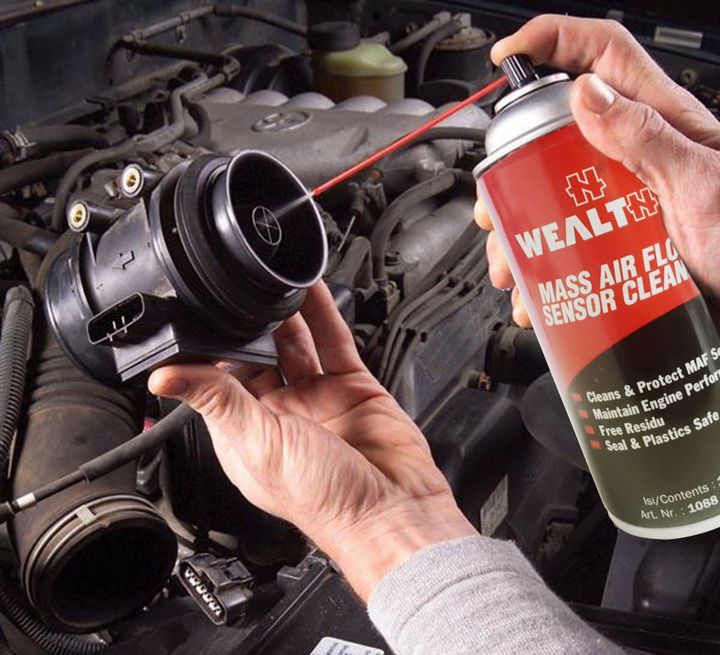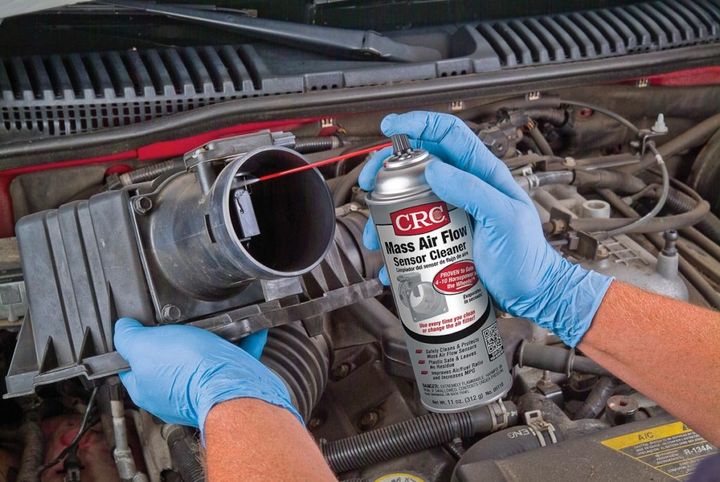


Maintaining your vehicle's mass air flow (MAF) sensor is crucial for optimal engine performance and fuel efficiency. This sensor plays a vital role in measuring the amount of air entering the engine, allowing the engine control unit (ECU) to calculate the precise amount of fuel needed for combustion. Over time, however, the MAF sensor can become contaminated with dirt, debris, or oil buildup, leading to inaccurate readings and various performance issues.
In this comprehensive guide, we'll explore the importance of a clean MAF sensor, the symptoms of a dirty sensor, and the benefits of regular cleaning. We'll then provide a step-by-step process for cleaning the MAF sensor using isopropyl alcohol, a safe and effective cleaning solution. Additionally, we'll cover the necessary materials, safety precautions, and testing procedures to ensure a successful cleaning process.

The mass air flow sensor is a critical component of the engine management system. It accurately measures the amount of air entering the engine, allowing the ECU to precisely calculate the required fuel quantity for optimal combustion. A clean and well-functioning MAF sensor ensures efficient fuel delivery, resulting in improved engine performance, better fuel economy, and reduced emissions.
When the MAF sensor becomes contaminated with dirt, debris, or oil buildup, it can provide inaccurate air flow readings to the ECU. This can lead to various performance issues, as outlined in the following table:
| Performance Issue | Description |
|---|---|
| Rough Idling | The engine may idle erratically or inconsistently when the MAF sensor is dirty. |
| Loss of Power | A contaminated MAF sensor can cause a noticeable decrease in engine power and acceleration. |
| Decreased Fuel Efficiency | Inaccurate air flow readings can result in improper fuel delivery, leading to reduced fuel economy. |
| Stalling | In severe cases, a dirty MAF sensor may cause the engine to stall or shut off unexpectedly. |
| Hesitation During Acceleration | The vehicle may experience hesitation or lag when accelerating due to incorrect fuel delivery. |
Regularly cleaning the MAF sensor offers several benefits. By removing contaminants and restoring accurate air flow readings, you can expect improved fuel efficiency, smoother acceleration, and a more stable idle. Additionally, a clean MAF sensor can help extend the sensor's lifespan, potentially saving you from the cost of premature replacement.
Before beginning the cleaning process, it's essential to gather the necessary materials. Isopropyl alcohol, also known as rubbing alcohol, is a safe and effective cleaning solution for the MAF sensor. You'll also need clean rags or paper towels, a soft-bristled brush (optional), and gloves (recommended) for protection.
The location of the MAF sensor can vary depending on the make and model of your vehicle. Typically, it is situated between the air filter housing and the throttle body, near the engine's air intake system. Consult your vehicle's owner's manual or a repair guide for specific instructions on locating the MAF sensor in your car.
Once you've located the MAF sensor, the next step is to disconnect and remove it from its housing. First, disconnect the electrical connector to prevent any potential damage. Then, carefully remove the sensor from its housing, taking care not to touch the delicate components. Handling the sensor improperly can lead to damage or inaccurate readings.
After removing the MAF sensor, place it on a clean surface, such as a workbench or a clean rag. Begin by using a clean rag or paper towel to gently wipe away any visible dirt or debris from the sensor's exterior.
Next, apply a small amount of isopropyl alcohol directly onto the sensor's hot wire or plate. Avoid submerging the sensor in alcohol or allowing excessive liquid to enter the sensor's housing, as this can cause damage. If necessary, use a soft-bristled brush to gently remove any stubborn buildup or deposits from the hot wire or plate.
In cases of stubborn buildup or deposits on the hot wire or plate, a soft-bristled brush can be used to gently remove the contaminants. Exercise caution and avoid applying excessive pressure, as the sensor components are delicate.
After cleaning the sensor with alcohol, it's crucial to allow it to air dry completely before proceeding to the next step. Ensure that no moisture remains on the sensor's components, as this can lead to inaccurate readings or potential damage.
Once the MAF sensor is completely dry, carefully reinstall it into its housing, ensuring a secure fit. Proper reinstallation is essential for accurate air flow readings and optimal performance.

After reinstalling the sensor, reconnect the electrical connector, making sure it is properly seated and secured.
With the MAF sensor reinstalled and the electrical connector reconnected, start the vehicle and allow the engine to idle for a few minutes. This will allow the engine management system to recalibrate and adjust to the clean sensor.
To verify the success of the cleaning process, take the vehicle for a test drive. Pay attention to any improvements in performance, such as smoother acceleration, better fuel efficiency, and a more stable idle. If you encounter any difficulties or the performance issues persist, it may be advisable to seek professional assistance from a qualified mechanic.
Here's a table summarizing the steps for reinstallation and testing:
| Step | Description |
|---|---|
| 1. Reinstall the MAF Sensor | Carefully reinstall the sensor into its housing, ensuring a secure fit. |
| 2. Reconnect the Electrical Connector | Reconnect the electrical connector, making sure it is properly seated. |
| 3. Start the Vehicle and Allow It to Idle | Start the engine and let it idle for a few minutes to recalibrate. |
| 4. Test Drive the Vehicle | Take the vehicle for a test drive, paying attention to any improvements in performance. |
| 5. Seek Professional Assistance (if needed) | If issues persist, seek assistance from a qualified mechanic. |
When working with isopropyl alcohol or any other cleaning solutions, it's essential to work in a well-ventilated area. This will help prevent the inhalation of fumes and ensure a safe working environment.
To protect your hands from the cleaning solution, it's recommended to wear gloves during the cleaning process. Isopropyl alcohol can cause skin irritation or dryness with prolonged exposure.
Exercise caution when handling isopropyl alcohol, and avoid contact with your eyes or skin. If accidental contact occurs, flush the affected area with water immediately.
Isopropyl alcohol is a flammable liquid, so it's crucial to keep the cleaning solution away from open flames or ignition sources. Follow proper safety protocols and exercise caution when working with flammable materials.
Here's a table summarizing the safety precautions:
| Precaution | Description |
|---|---|
| Well-Ventilated Area | Work in a well-ventilated area to prevent inhalation of fumes. |
| Wear Gloves | Wear gloves to protect your hands from the cleaning solution. |
| Avoid Eye and Skin Contact | Exercise caution and avoid contact with eyes or skin. |
| Keep Away from Open Flames | Keep the cleaning solution away from open flames or ignition sources. |
Maintaining a clean mass air flow sensor is essential for optimal engine performance, fuel efficiency, and emissions control. By following the step-by-step guide outlined in this article, you can effectively clean your MAF sensor using isopropyl alcohol, a safe and readily available cleaning solution. Regular cleaning can help prevent costly repairs and ensure your vehicle operates at its best. Remember to follow the safety precautions and seek professional assistance if you encounter any difficulties during the cleaning process.
The mass air flow sensor measures the amount of air entering the engine, allowing the engine control unit (ECU) to calculate the precise amount of fuel needed for optimal combustion. It plays a crucial role in maintaining the proper air-fuel ratio for efficient engine performance.
Yes, a dirty MAF sensor can cause engine stalling, as it provides inaccurate air flow readings to the ECU, leading to an improper air-fuel mixture and potential stalling.
It is recommended to clean the MAF sensor every time the air filter is replaced or at least every 15,000 to 20,000 miles (24,000 to 32,000 km).
Yes, a faulty MAF sensor can potentially damage the catalytic converter by causing the engine to run too rich or too lean, exposing the converter to excessive heat or unburnt fuel.
No, it is not recommended to drive with a faulty MAF sensor, as it can lead to various performance issues, decreased fuel efficiency, and potential engine damage.
In most cases, a MAF sensor cannot be repaired and needs to be replaced if it is faulty or damaged beyond cleaning.
Common signs of a failing MAF sensor include rough idling, hesitation during acceleration, decreased fuel efficiency, stalling, and the illumination of the check engine light.
No, regular household cleaners should not be used to clean a MAF sensor, as they may contain harsh chemicals that can damage the sensitive components. Use a dedicated MAF sensor cleaner instead.
No, it is not necessary to disconnect the battery before cleaning the MAF sensor, as long as you follow the proper safety precautions and avoid touching any electrical components.
Yes, a dirty or clogged air filter can allow contaminants to pass through and accumulate on the MAF sensor, leading to inaccurate readings and potential performance issues.

Sarah isn't your average gearhead. With a double major in Mechanical Engineering and Automotive Technology, she dived straight into the world of car repair. After 15 years of turning wrenches at dealerships and independent shops, Sarah joined MICDOT to share her expertise and passion for making cars run like new. Her in-depth knowledge and knack for explaining complex issues in simple terms make her a valuable asset to our team.





